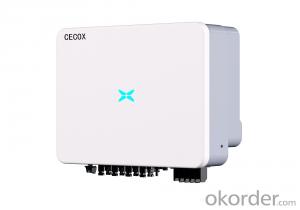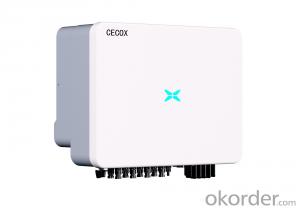30kW 33kW 36kW 40kW Three Phase On-Grid Solar Inverter
- Loading Port:
- China main port
- Payment Terms:
- TT or LC
- Min Order Qty:
- 30 unit
- Supply Capability:
- 500 unit/month
OKorder Service Pledge
OKorder Financial Service
You Might Also Like
Item specifice
CNBM 30kW 33kW 36kW 40kW Three Phase On-Grid Solar Inverter PV Solution
XG30kW-40kW Three Phase On-Grid Solar Inverter
XG30KTR | XG33KTR | XG36KTR | XG40KTR | |
Input(DC) | ||||
Max. Input Power | 48 kW | 52.8 kW | 57.6 kW | 64 kW |
Max. Input Voltage | 1100V | |||
Start Voltage | 250V | |||
Rated Input Voltage | 600V | |||
Full-load MPP Voltage Range | 500V-800V | |||
MPPT Voltage Range | 200V-1000V | |||
Number of MPP Trackers | 3 | 4 | ||
String per MPPT | 2 | |||
Max.Current per MPPT | 26A | |||
Max.Short Circuit Current per MPPT | 32A | |||
Output(AC) | ||||
Max. Output Current | 48.3 A | 53 A | 57.8 A | 64.3 A |
Rated Output Power | 30 kW | 33 kW | 36 kW | 40 kW |
Max. Output Power | 33.3 kVA | 36.6 kVA | 39.6 kVA | 44 kVA |
Rated Grid Frequency | 50 Hz / 60 Hz | |||
Rated Grid Voltage | 230Vac / 400Vac, 3L / N / PE | |||
Power Factor | >0.99 (0.8 leading~0.8 lagging) | |||
THDi | <3% (Rated Power) | |||
Efficiency | ||||
Max. Efficiency | 98.60% | |||
European Efficiency | 98.50% | |||
MPPT Efficiency | 99.90% | |||
Protection | ||||
DC reverse polarity protection | Yes | |||
Anti-Islanding protection | Yes | |||
AC short circuit protection | Yes | |||
Residual current monitoring unit | Yes | |||
Insulation resistance monitoring | Yes | |||
Ground fault monitoring | Yes | |||
Grid monitoring | Yes | |||
PV string monitoring | Yes | |||
Surge protection | Type II | |||
AFCI protection | Optional | |||
Communication | ||||
Display | LED / LCD / WiFi+App | |||
Communication | Standard:RS485 Optional:WiFi / GPRS / Ethernet | |||
Standard Compliance | ||||
Grid Connection Standards | IEC 61727, IEC 62116, IEC 60068, IEC 61683, VDE-AR-N 4110:2018, VDE-AR-N 4105:2018, VDE-AR-N 4120:2018, EN 50549, AS/NZS 4777.2:2020, CEI 0-21, VDE0126-1-1/A1 VFR 2014,UTE C15-712-1:2013, DEWA DRRG, NRS 097-2-1, MEA/PEA, C10/11, G98/G99 | |||
Safety/EMC | IEC 62109-1:2010, IEC 62109-2:2011, EN 61000-6-2:2005, EN 61000-6-3:2007/A1:2011 | |||
General Data | ||||
Dimensions (W*H*D) | 600 x 430 x 230 mm | |||
Weight | 30 kg | 32 kg | ||
Operating Temperature Range | -30° C ~ +60° C | |||
Cooling Method | Smart Cooling | |||
Protection Degree | IP66 | |||
Max. Operating Altitude | 4000 m | |||
Relative Humidity | 0 ~ 100% | |||
Topology | Transformerless | |||
Night Power Consumption | < 1 W | |||
MARKETING & SERVICE NETWORK
CNBM global sales team provides customers with professional and efficient pre-sale,
in sale and after-sale services, and enhances the added value of the brand with high-quality services.
Products Details:
High voltage protection Over load protection
Battery reverse connected protection Dust-proof
Low voltage protection Overheating protection
Output short-circuit protection Insect prevention
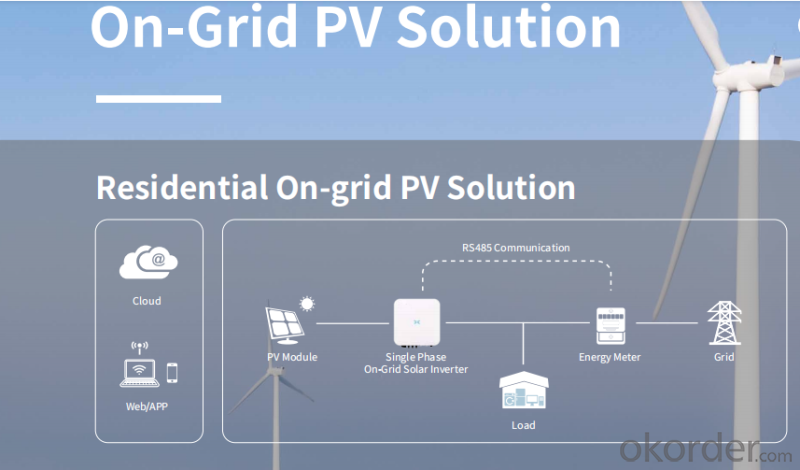
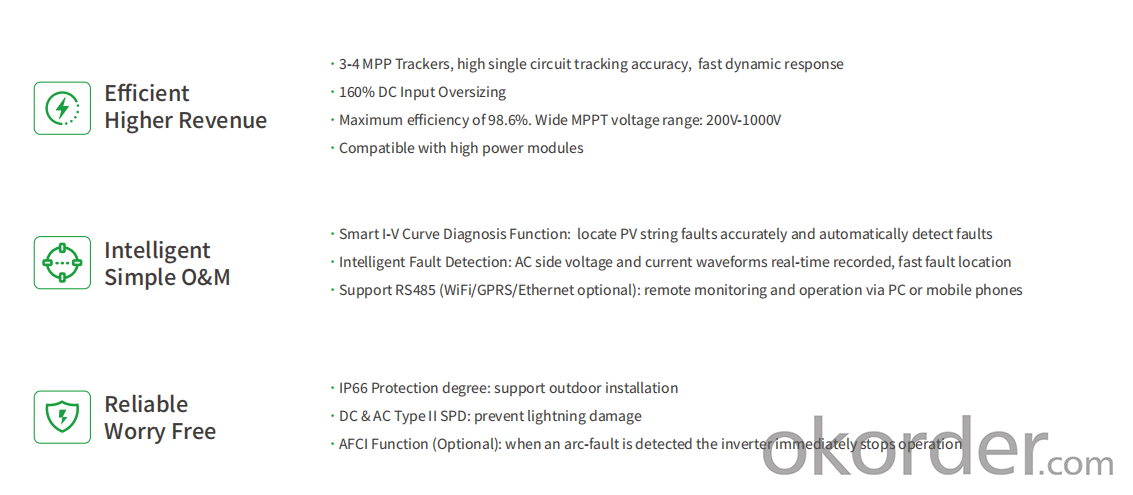
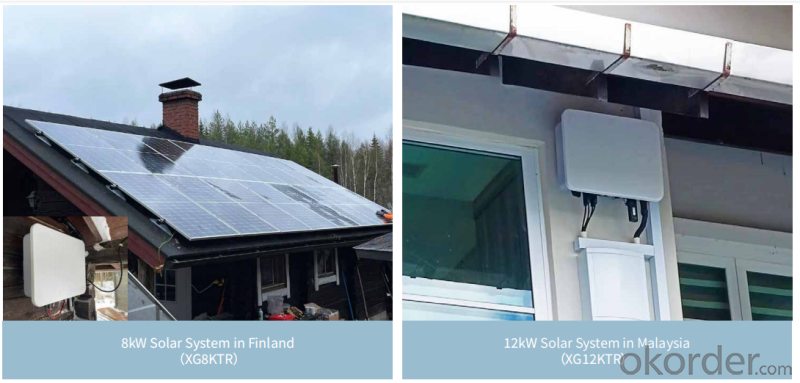

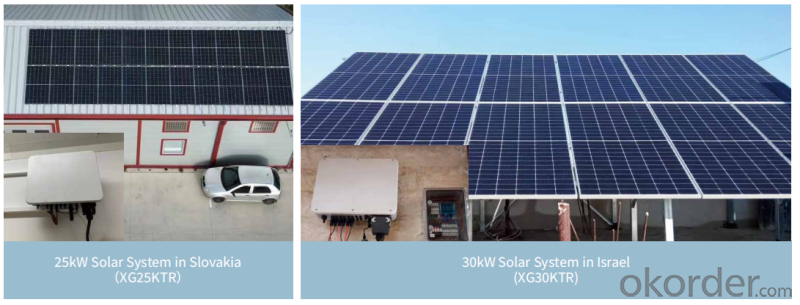

- Q:How does the input voltage range affect the performance of a solar inverter?
- The input voltage range of a solar inverter directly impacts its performance. A wider input voltage range allows the inverter to adapt to various solar panel configurations and environmental conditions, maximizing the system's overall efficiency. A limited input voltage range may result in reduced efficiency and output power, as the inverter may not be able to effectively convert the varying voltages produced by the solar panels. Additionally, a wider input voltage range provides flexibility in system design and allows for the incorporation of additional solar panels in the future without the need for significant modifications.
- Q:How do you maintain a solar inverter?
- To maintain a solar inverter, regular inspections and cleaning are essential. It is crucial to check for any signs of damage or loose connections, and make sure the inverter is properly ventilated to prevent overheating. Additionally, keeping the surrounding area clean and free from any debris or obstructions can help optimize its performance. It is recommended to follow the manufacturer's guidelines and consult with a professional for any specific maintenance requirements.
- Q:How does a solar inverter handle voltage drop in long cable runs?
- A solar inverter compensates for voltage drop in long cable runs by boosting the voltage to ensure efficient power transmission.
- Q:How does a solar inverter handle voltage fluctuations during grid disturbances?
- A solar inverter handles voltage fluctuations during grid disturbances by continuously monitoring the grid voltage. When it detects a fluctuation or disturbance, it adjusts its own output voltage to match the grid's voltage. This ensures that the solar inverter remains synchronized with the grid and delivers stable electricity without causing any damage to the connected appliances or the grid itself.
- Q:How does a solar inverter handle grid synchronization during startup?
- A solar inverter handles grid synchronization during startup by employing advanced control algorithms. It continuously monitors the grid voltage and frequency, aligns itself with the grid parameters, and gradually increases its output power to match the grid. This synchronization process ensures that the solar inverter seamlessly integrates with the grid and provides stable and synchronized power generation.
- Q:What is the role of a power quality analyzer in a solar inverter?
- A power quality analyzer in a solar inverter is responsible for monitoring and analyzing various electrical parameters such as voltage, current, frequency, harmonics, and power factor. It ensures that the solar inverter is operating efficiently and delivering high-quality power to the grid. By detecting and diagnosing any power quality issues, the analyzer helps in identifying potential problems, optimizing energy production, and maintaining the overall performance and reliability of the solar inverter system.
- Q:How does a solar inverter contribute to reducing carbon emissions?
- A solar inverter plays a crucial role in reducing carbon emissions by converting the direct current (DC) electricity generated by solar panels into alternating current (AC) electricity that can be used to power homes and businesses. By enabling the integration of solar power into the electrical grid, solar inverters help to replace conventional fossil fuel-based electricity generation, which is a major source of carbon emissions. This shift towards clean and renewable solar energy helps to reduce carbon emissions and mitigate the adverse effects of climate change.
- Q:Can a solar inverter provide power during a blackout?
- No, a solar inverter cannot provide power during a blackout.
- Q:What is the purpose of a solar inverter in a solar power system?
- The purpose of a solar inverter in a solar power system is to convert the direct current (DC) electricity produced by the solar panels into alternating current (AC) electricity that can be used to power electrical devices in homes and businesses.
- Q:What is the power factor correction capability of a solar inverter?
- The power factor correction capability of a solar inverter refers to its ability to adjust the power factor of the electricity it produces. A power factor is a ratio that measures the efficiency of electrical power usage, with a value between 0 and 1. A solar inverter with good power factor correction capability can optimize the power factor towards unity (1), which indicates maximum efficiency. This helps in minimizing reactive power and reducing energy wastage, resulting in a more efficient and effective utilization of solar power.
1. Manufacturer Overview |
|
|---|---|
| Location | |
| Year Established | |
| Annual Output Value | |
| Main Markets | |
| Company Certifications | |
2. Manufacturer Certificates |
|
|---|---|
| a) Certification Name | |
| Range | |
| Reference | |
| Validity Period | |
3. Manufacturer Capability |
|
|---|---|
| a)Trade Capacity | |
| Nearest Port | |
| Export Percentage | |
| No.of Employees in Trade Department | |
| Language Spoken: | |
| b)Factory Information | |
| Factory Size: | |
| No. of Production Lines | |
| Contract Manufacturing | |
| Product Price Range | |
Send your message to us
30kW 33kW 36kW 40kW Three Phase On-Grid Solar Inverter
- Loading Port:
- China main port
- Payment Terms:
- TT or LC
- Min Order Qty:
- 30 unit
- Supply Capability:
- 500 unit/month
OKorder Service Pledge
OKorder Financial Service
Similar products
New products
Hot products
Hot Searches
Related keywords

